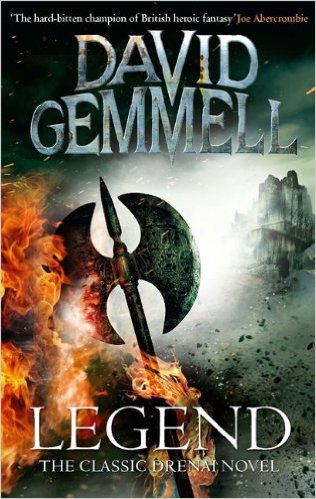 In the 70s, a journalist was diagnosed with cancer. He had reason to suspect it was terminal. To take his mind off the thing growing in his body, he started work on a fantasy novel about a mighty fortress under siege from a vast army. He left the final chapter unwritten. Did the fortress stand, or did it fall? He didn’t know. Not every question has an answer, but to even stand a chance of resolution you must do one thing: live.
In the 70s, a journalist was diagnosed with cancer. He had reason to suspect it was terminal. To take his mind off the thing growing in his body, he started work on a fantasy novel about a mighty fortress under siege from a vast army. He left the final chapter unwritten. Did the fortress stand, or did it fall? He didn’t know. Not every question has an answer, but to even stand a chance of resolution you must do one thing: live.
Gemmell didn’t die, and the fortress didn’t fall, and heroic fantasy got a new classic: forty years later, Legend’s still a fun read. And a big one. Every single character is so massive and archetypal that they almost threaten to overpower the story, like ships so big that they displace oceans in their passage.
The Delnai empire is weakening, collapsing from inside from corruption and decadence. The warring Nadir tribes to the north have united under the charismatic warlord Ulric, and are invading. The end of an empire seems to be at hand. A few thousand ill-prepared Delnai warriors assemble at the ancient fortress of Dros Delnoch, where they await their fate. They are joined by legendary hero Druss the Legend, who was instrumental in defending the Delnai from an invasion decades ago. But he’s an old man, in poor health.
Parallels to real world historical events and figures show through (though it always puzzled me that Gemmell’s I-Can’t-Believe-It’s-Not-Mongols are lead by a man with a High Germanic name). Gemmell doesn’t do anything wholly new, but he’s an expert at tweaking things that need to be tweaked, so that the experience is one of freshness. When Druss arrives at Dros Delnoch, he finds it commanded by a laughably incompetent martinet whose appointment is political. And yeah, we get the expected scenes of Druss Delnoch whipping this stupid guy into shape like R Lee Ermey, but where Gemmell ends up going with this character…well, it took my by surprise. He didn’t have to go there, but I’m glad he did.
Gemmell has said that one of his goals with this story was to “fix” the Alamo. It’s hard to have heroes in the 21st century, history has become too good and now those stirring American frontier stories make you think of plague blankets, forced marches, slavery, et cetera. Legend is the Alamo story as Gemmell thinks it should have been, with great deeds and golden heroes that will never be sullied by history.
The first half of the novel is a slow, burning build, like lactic acid in a muscle, as the fortress prepares for war. The second half of the novel is virtually a single solid action scene spanning weeks. I liked the way the siege drags on for so long that soon everyone loses hope…but they look at their hands, and those hands are still fighting. Druss’s tale is concluded in spectacular fashion, and you almost wish the book had ended there, because nothing that comes after it matches it.
This is “first novel” territory, and there’s things I never liked. The sheer overdose of heroics kind of cheapens the effect – everyone here’s a master warrior, or magician, or strategist. And there’s a kind of tacky “DnD” element that Gemmell would carry on throughout his career: whenever he wants to demonstrate a character’s martial prowess, he has them kill a bunch of random bandits.
Despite its roughness, Legend is the book that made Gemmell’s name. The action is fast and unrelenting, the pace never flags, and bathos is laid on with a trowel. Forty years later, the fortress still hasn’t fallen.
No Comments »
Comments are moderated and may take up to 24 hours to appear.
No comments yet.
